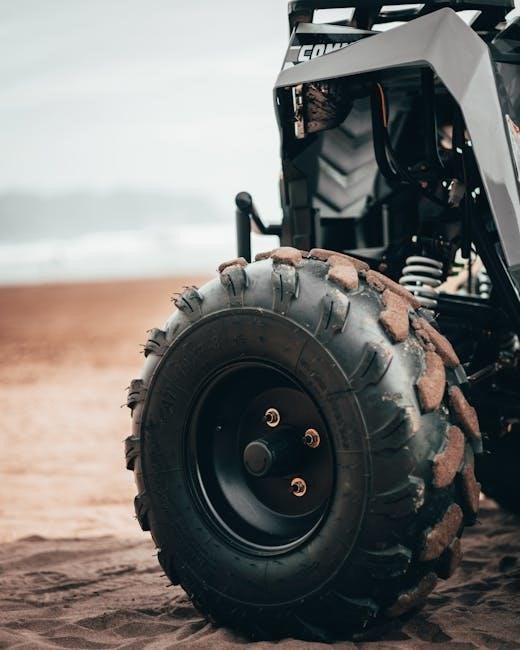Understanding ATV Tire Size Guide
Choosing the right ATV tire size is crucial for performance‚ load capacity‚ and handling. Understanding tire size codes‚ load ratings‚ and tread patterns ensures optimal stability and control for various terrains. Proper tire selection enhances safety‚ while regular maintenance like pressure checks and inspections guarantees longevity and reliability‚ ensuring your ATV operates at its best under all conditions.
Key Factors to Consider When Choosing ATV Tires
When selecting ATV tires‚ several critical factors must be considered to ensure optimal performance and safety. First‚ tire size is essential‚ as it directly impacts handling and stability. Next‚ evaluate the load rating and ply rating to ensure the tires can support the ATV’s weight and payload. The terrain type is another crucial factor‚ as tread patterns vary for mud‚ trails‚ or snow. Additionally‚ consider the speed rating to match your riding style. Finally‚ choose a reputable brand known for durability and quality. By addressing these factors‚ you can select tires that enhance your ATV’s performance‚ safety‚ and overall riding experience‚ ensuring reliability across diverse conditions and terrains. Proper selection is vital for maximizing efficiency and enjoyment.
Importance of Tire Size for ATV Performance
Tire size plays a vital role in determining an ATV’s performance and stability. Properly sized tires ensure optimal ground clearance‚ which improves maneuverability and reduces the risk of scraping or getting stuck. Incorrect tire size can lead to poor handling‚ reduced traction‚ and increased wear. Oversized tires may compromise acceleration and responsiveness‚ while undersized tires can limit stability and load capacity. Matching the tire size to the ATV’s specifications ensures smooth operation and maximizes safety. Always refer to the manufacturer’s guidelines to select tires that align with your vehicle’s design and intended use‚ guaranteeing enhanced performance‚ control‚ and reliability in various riding conditions and terrains.

How to Read ATV Tire Sizes
ATV tire sizes are typically marked as three numbers (e.g.‚ 25-10-12)‚ representing height‚ width‚ and rim diameter. This standard format helps in easy identification and selection.

Understanding the Tire Size Code (e.g.‚ 25-10-12)
The tire size code‚ such as 25-10-12‚ consists of three key measurements: the first number (25) represents the tire’s diameter‚ the second (10) is the width‚ and the third (12) is the rim diameter. This format is standard for ATV tires and helps in selecting the right fit for your vehicle. The diameter determines ground clearance and stability‚ while the width affects traction and handling. The rim diameter must match your ATV’s wheel size for proper installation. Understanding this code ensures compatibility and optimal performance for various terrains and riding conditions‚ making it essential for safe and effective tire selection.
Difference Between Standard and Metric Tire Sizes
The primary distinction between standard and metric tire sizes lies in their measurement units and designations. Standard sizes‚ commonly used in the U.S.‚ are typically expressed in inches‚ such as 25-10-12‚ where the numbers represent diameter‚ width‚ and rim size. Metric sizes‚ used internationally‚ often utilize millimeters and may include additional designations. Standard sizes focus on the tire’s overall diameter‚ while metric sizes emphasize width and aspect ratio. This differentiation affects fitment and performance‚ necessitating careful consideration to ensure compatibility and safety. Understanding these differences is essential for selecting tires that match your ATV’s specifications and meet your riding needs effectively.

Performance Ratings and Load Capacity
Performance ratings and load capacity are critical for ensuring your ATV tires can handle the weight and stress of your riding style and terrain demands effectively and safely.
Speed Rating and Performance Requirements
The speed rating‚ often referred to as the performance rating‚ determines the maximum safe speed your ATV tires can maintain over time. This rating is crucial for ensuring optimal handling and stability‚ especially during high-speed rides or demanding terrain. Tires with higher speed ratings are designed to withstand heat buildup and maintain traction at faster speeds. Always match your tire’s speed rating to your ATV’s intended use and riding style. For example‚ tires with a higher speed rating are ideal for racing or aggressive trail riding‚ while lower ratings may suffice for casual‚ low-speed activities. Proper speed-rated tires ensure safety‚ durability‚ and peak performance under various conditions.
Load Rating and Ply Rating Explained
Load rating indicates the maximum weight an ATV tire can safely support‚ while ply rating reflects the tire’s strength and durability. Higher ply ratings‚ such as 6-ply or 8-ply‚ denote greater resistance to punctures and heavier loads. Always ensure your tire’s load rating matches or exceeds your ATV’s gross vehicle weight. The ply rating is crucial for harsh terrains like mud or rocky trails‚ where durability is key. Proper load and ply ratings prevent tire failure‚ ensuring safety and optimal performance under various operating conditions and terrains. Match these ratings to your ATV’s specifications and riding habits for reliability and extended tire life.

Tire Diameter and Width Options
ATV tire sizes range from 20 to 30 inches in diameter and vary in width. The optimal diameter and width depend on the ATV model and riding style.
Optimal Tire Diameter for Different ATV Models
The optimal tire diameter for your ATV depends on its intended use and model. Smaller ATVs typically use tires with diameters ranging from 20 to 24 inches‚ providing better maneuverability and control. Larger ATVs‚ especially those designed for mud or heavy-duty applications‚ often require tires with diameters between 26 to 30 inches. These larger tires offer improved ground clearance and stability in challenging terrains. Always consult your vehicle’s manufacturer specifications to ensure compatibility and safety. Proper tire diameter ensures optimal performance‚ handling‚ and reduces the risk of mechanical stress. Choosing the right size enhances your riding experience and extends the life of your ATV’s suspension and drivetrain.
Choosing the Right Tire Width for Your Needs
Tire width plays a significant role in determining your ATV’s stability‚ traction‚ and overall performance. Wider tires provide better stability and flotation in soft terrains like mud or sand but may compromise agility on tighter trails. Narrower tires‚ on the other hand‚ offer improved maneuverability and are ideal for hard-packed surfaces or wooded areas. Always consider your riding style and the terrain you frequent most. For example‚ mud-specific tires often feature wider widths for enhanced grip‚ while trail tires are narrower for precision. Consult your ATV’s manufacturer specifications to ensure the chosen width aligns with your vehicle’s capabilities and suspension setup. Balancing width with other factors like diameter and tread pattern ensures optimal performance for your specific needs.
Terrain-Specific Tire Considerations
Different terrains demand specialized tires for optimal performance. ATV tires are designed for mud‚ trails‚ sand‚ and snow‚ each requiring unique tread patterns and sizes for maximum traction and control.
Mud Tires: Size and Tread Patterns
Mud tires are designed for maximum traction in muddy conditions. They typically feature aggressive tread patterns with deep lugs to expel mud and maintain grip. Larger diameters and wider widths improve flotation and stability in soft terrain‚ while specialized compounds enhance durability. The right size ensures proper clearance and weight distribution‚ preventing bogging. Riders should consider their ATV’s make and model to select appropriate sizes‚ as oversized tires can affect handling. Proper maintenance‚ like regular pressure checks‚ is crucial for optimal performance. Always match tire size and type to riding conditions for safety and efficiency.
Trail and All-Terrain Tires: Size Recommendations
Trail and all-terrain tires balance versatility and durability for diverse riding conditions. Tires with moderate tread patterns offer excellent grip on both hard surfaces and soft trails‚ while maintaining smooth handling. Sizes typically range from 23 to 27 inches in diameter‚ providing a balance between ground clearance and stability. Wider tires improve lateral traction‚ while narrower options enhance maneuverability in tight spaces. Riders should match tire size to their ATV’s specifications to avoid performance issues. Proper sizing ensures optimal weight distribution and control‚ reducing the risk of tipping. Always consult the manufacturer’s guidelines for size recommendations tailored to specific models and terrains.
Snow and Sand Tires: Specialized Sizes and Designs
Snow and sand tires are designed for extreme conditions‚ requiring specialized sizes and tread patterns. For snowy terrains‚ tires feature aggressive tread designs with deep lugs and studs for maximum traction on ice and packed snow. Sizes often range from 24 to 30 inches in diameter‚ with narrower widths to cut through deep snow effectively. In sandy environments‚ tires are wider with paddle-like treads to maximize floatation and prevent sinking. These tires are typically larger in diameter to cover more surface area. Materials are also adapted for cold or high-heat conditions‚ ensuring durability. Proper tire pressure is critical for performance‚ and riders should consult manufacturer guidelines for optimal sizing and inflation levels to ensure safety and control in these challenging environments.
Tire Maintenance and Upkeep
Regular tire inspections‚ proper pressure checks‚ and cleaning rims are essential for optimal ATV performance. Follow manufacturer guidelines for maintenance to ensure safety‚ durability‚ and consistent traction in all conditions.
Importance of Proper Tire Pressure
Maintaining proper tire pressure is essential for optimal ATV performance‚ safety‚ and longevity. Under-inflation can lead to reduced traction‚ uneven wear‚ and increased risk of punctures. Always check pressure when tires are cold‚ as driving can heat them up and give inaccurate readings. Refer to the Tire Pressure and Maximal Load label on your ATV for recommended levels‚ which vary by load and terrain. Proper pressure ensures better handling‚ improved fuel efficiency‚ and prevents premature wear. Neglecting this can compromise stability‚ especially at higher speeds or with heavy loads. Regular checks‚ especially before long rides‚ are crucial for reliability and safety on all terrains.
Regular Inspection and Maintenance Tips
Regular inspections are vital for ensuring ATV tire longevity and performance. Check for signs of wear‚ such as uneven tread‚ cuts‚ or punctures. Remove debris lodged in the tread to prevent damage. Inspect the sidewalls for cracks or blisters‚ which may indicate age or excessive stress. Rotate tires periodically to promote even wear‚ especially if your ATV is used frequently or carries heavy loads. Clean rims before reinstalling tires to ensure a proper seal. Always follow the manufacturer’s maintenance schedule and guidelines for specific terrains. Addressing issues early prevents costly repairs and enhances safety. Consistent upkeep ensures your tires perform optimally‚ providing reliability and control across various riding conditions;
